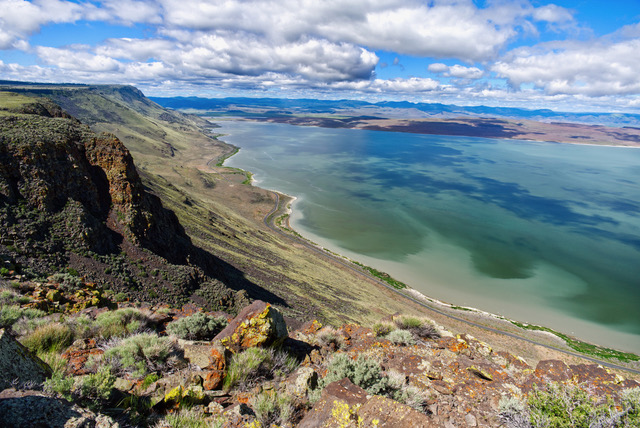Ron Larson
Lake Abert: An Irreplaceable, Ecological Gem
Lake Abert is the only hypersaline lake in Oregon, one of three hypersaline lakes in the western U.S., and is the largest saline lake in the Pacific Northwest. This unique […]
Read MoreGreg Burke
Two invertebrates are able to tolerate the salinity of Lake Abert — the alkali fly (Ephydra hians) and brine shrimp (Artemia franciscana) — but only when water salinity levels are between 3 and 8%. When salinity drops below or rises above that threshold, the fly and shrimp populations plummet due to inhospitable conditions.
Since these two species serve as the main source of food for migrating birds, reductions in brine shrimp or alkali fly abundance create a major disruption along the Pacific Flyway.
Unfortunately, water withdrawals, reservoir construction and drought have reduced water flow into the lake, increasing its salinity or drying up the lake altogether. With the food gone, migratory birds can no longer stop at this lake to replenish their energy.
Lake Abert is an indispensable ecosystem where birdwatchers and nature lovers have appreciated the wonders of the salt lake for decades. But the future of this lake is at risk.
Although Lake Abert and the adjacent Abert Rim are identified by the Bureau of Land Management as Areas of Critical Environmental Concern, the lake itself does not have any water rights so upstream withdrawals from the Chewaucan River, can leave the lake with little or no water, especially during drought years.
Long-term conservation, management and restoration of the unique habitat at Lake Abert requires a deep understanding of its hydrology, biology and ecology. It also requires the state of Oregon to improve water management, measurement, and regulation, and for local, regional and national stakeholders to work together to ensure the lake is provided the water it needs to thrive.
Ron Larson
Lake Abert is the only hypersaline lake in Oregon, one of three hypersaline lakes in the western U.S., and is the largest saline lake in the Pacific Northwest. This unique […]
Read MoreRon Larson
Lake Abert’s delicate ecosystem depends on consistent and reliable fresh water inputs to maintain optimal salinity to support a complex food web that feeds the abundant birdlife at the lake. […]
Read MoreRon Larson
Lake Abert — and the birds that depend on it — is under constant threat as the ongoing drought exacerbates the impacts of poor water management, resulting in reduced inflows […]
Read More
Lake Abert is a rich ecosystem teeming with life. See more images of this incredible saline environment in our storybook.
Flip throughVision We envision a high desert in Oregon where eight million acres of public lands are conserved to ensure that fish and wildlife thrive and wild places exist for all […]
Read MoreSign up for ONDA’s free e-newsletter to stay aware of public lands issues, hear about ONDA events and build your knowledge of the natural history of Oregon’s high desert.
Read MoreIn the southeastern corner of Oregon, a hidden wonder shimmers — Lake Abert. When full, Lake Abert covers 65 square miles and is the sixth largest lake in Oregon. It […]
Read MoreAt 4,700 feet tall, Sutton Mountain towers over the surrounding landscape. With a steep, craggy west side and a rolling, grassy eastern face, the mountain has an alluring Jekyll and […]
Read MoreOregon Natural Desert Association developed the Oregon Desert Trail to showcase the most spectacular natural areas of the state’s dry side, including Hart Mountain National Antelope Refuge, Steens Mountain, and […]
Read MoreWithin an hour’s drive from Bend and just west of Terrebonne, the rugged canyons of Whychus-Deschutes remain astonishingly wild.
Read MoreDeep canyons, remnant old-growth pine forests, and rolling hills covered with juniper, sagebrush, and bunchgrass define the character of the remarkable public lands included in the Horse Heaven and Cathedral […]
Read MoreDrawn to the exhilarating rapids, remote canyons, and thriving fishery, more than 10,000 people float the 72-mile long Clarno to Cottonwood stretch of the Lower John Day River each year.
Read MoreGet Involved in Desert Conservation The Oregon Natural Desert Association’s mission is to protect, restore, and defend Oregon’s desert areas, and Oregon Desert Trail explorers are integral in these efforts. […]
Read MoreBe advised! Stretches of the Oregon Desert Trail route are exceedingly remote. Read the Oregon Desert Trail guidebook descriptions in detail and seriously consider any notes on water scarcity or […]
Read More